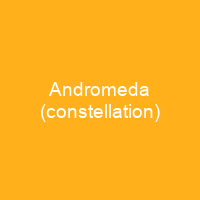Andromeda is one of the 48 constellations listed by the 2nd-century Greco-Roman astronomer Ptolemy. Located north of the celestial equator, it is named for Andromeda, daughter of Cassiopeia, in the Greek myth, who was chained to a rock to be eaten by the sea monster Cetus. Because of its northern declination, Andromeda is visible only north of 40° south latitude.
About Andromeda (constellation) in brief

In Chinese astronomy, the stars that made up Andromeda were members of four different constellation that had astrological and mythological significance. A constellation related to Andromeda also exists in Hindu mythology. In Greek tradition, Andromeda has its roots most firmly in theGreek tradition, though a female figure in Andromeda’s location had appeared earlier in Babylonian astronomy. The myth recounts that the couple had nine children together – seven sons and two daughters – and founded Mycenae and its Persideae dynasty. After Andromeda’s death Athena placed her in the sky as a constellation, to honor her. Three of the neighboringconstellations represent characters in the Perseus myth, while Cetus retreats to beyond Pisces. Andromeda is the most prominent constellation during autumn evenings in the Northern Hemisphere, along with several other constellation named for characters in that myth, such as Perseus and Perseus, as well as several others named for other mythological characters. The Blue Snowball Nebula, a planetary nebula, is visible in a telescope as a blue circular object. Andromeda’s brightest star, Alpha and Beta, is a binary star that has been counted as a part of Pegasus, while Gamma andromedae is a colorful binary and a popular target for amateur astronomers.
You want to know more about Andromeda (constellation)?
This page is based on the article Andromeda (constellation) published in Wikipedia (as of Nov. 22, 2020) and was automatically summarized using artificial intelligence.







